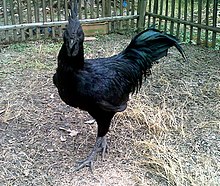Ayam Cemani
 Cemani hen | |
| Country of origin | Indonesia |
|---|---|
| Traits | |
| Weight |
|
| Skin color | Black with a turquoise glow on the rooster neck side and tail. |
| Egg color | Tinted/cream/light blue |
| Comb type | Single |
| Classification | |
| |

The Ayam Cemani is a rare breed of chicken from Indonesia. They have a dominant gene that causes hyperpigmentation (fibromelanosis), making the chicken mostly black, including feathers, beak, and internal organs. The Cemani is a very popular gamecock for cockfighting in Bali because their thighs have much more muscle compared to other chickens, which leads to them being much faster.[1]
Etymology
Ayam means "chicken" in Indonesian, while cemani (originally a Sanskrit word) means "thoroughly black" (down to the bones).[2]
Origin
As a pure Indonesian breed, the breed originated from the island of Java, Indonesia, and has probably been used since the 12th century for religious and mystical purposes.[3]
The breed was described by Dutch colonial settlers[4] and first imported to Europe in 1998 by Dutch breeder Jan Steverink.[citation needed] Currently, this breed of chicken is kept in the Netherlands, Belgium, Germany, Slovakia, Sweden, Italy and the Czech Republic. Ayam Cemani may have also been brought to Europe by Dutch seamen.
Description
The price is at least 45 dollars but up to 500 for an adult with imported specimens being up to 2,500. The optimal standard is that their beaks, tongues, combs and wattles appear black, and even their meat, and organs are black or gray. However contrary to popular belief, their bones are not actually black. Their blood is normally colored. They are a medium sized chicken that are known for their beautiful and unique look. They are usually a somewhat friendly bird but they are still relatively skittish. The birds' black color occurs as a result of excess pigmentation of the tissues, caused by a genetic condition known as fibromelanosis.[5] Fibromelanosis is also found in some other black or blue-skinned chicken breeds, such as the Silkie.[6][7]== The
See also
References
- PMID 25155871– via SCI.
- ^ "Arti kata cemani - Kamus Besar Bahasa Indonesia (KBBI) Online". kbbi.web.id. Retrieved 2020-07-08.
- ^ Solly, Meilan (September 19, 2019), These Chickens Have Jet Black Hearts, Beaks and Bones, retrieved May 18, 2020
- ^ Lukanov, H.; Genchev, A. (September 2013). "Fibromelanosis in domestic chickens" (PDF). Agricultural Sciences and Technology. 5 (3): 239–246.
- PMID 22135351.
- PMID 22216010.
- S2CID 25423912.
